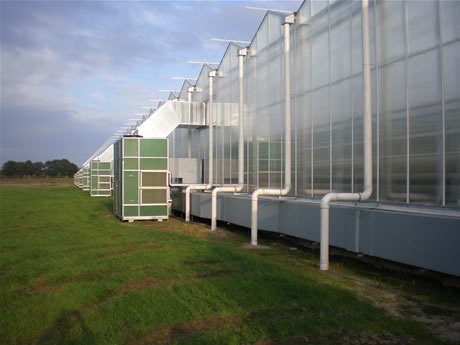
Features
Environmental Control
Structures & Equipment
Sustainable dehumidification of greenhouse air
October 28, 2009 By Wageningen University
 Oct. 28, 2009, Wageningen, the Netherlands – The best way for Dutch growers to dehumidify greenhouse air is
Oct. 28, 2009, Wageningen, the Netherlands – The best way for Dutch growers to dehumidify greenhouse air is
to let outside air in, according to one researcher.
Oct. 28, 2009, Wageningen, the Netherlands – The best way for Dutch growers to dehumidify greenhouse air is
to let outside air in, according to one researcher. Heating this outside air using the outflowing greenhouse
air can lead to considerable energy savings.
This is the result of research carried out by Jouke Campen with which he
hopes to obtain his doctorate at Wageningen University. Campen also says that
letting dry air in allows horticulturists to keep their energy screens closed
longer, offering further significant savings.

|
|
The technology for the energy-saving dehumidification of |
Campen studied various technologies for dehumidifying greenhouse air. He
initially expected the best results from condensation technologies in which
humid air flows past a large cold surface, causing the moisture on that surface
to condense. Campen presumed that this method would remove moisture from the
air and generate heat through condensation.
After extensive research, however, he discovered that the best approach
is to use comparatively dry outside air. The various condensation technologies
he studied turned out to be expensive and uneconomical, partly because they
required more energy to be “pumped around” than condensation heat alone. The
greenhouse air also appeared to cool quicker than expected and the condensation
systems themselves can be complex and costly.
Based on his research, Campen says that using outside air is the best
option. “Pre-heating inflowing outside air with outflowing greenhouse air can
result in considerable energy savings,” he reports. “And horticulturists can
also save up to 15 per cent by using cheap, dry air to keep their energy
screens closed longer. They do not have to open the screens until the solar
irradiation is such that greenhouse heating is rendered unnecessary.”
The technology has already been applied in a strawberry greenhouse.
“Although the investment is yet to become cost-effective due to low energy
prices, there is interest from horticulturists and suppliers,” Campen
concludes. “I think there is a good chance that this method for the
dehumidification of greenhouse will be a commonly used technology within a few
years.”
Print this page